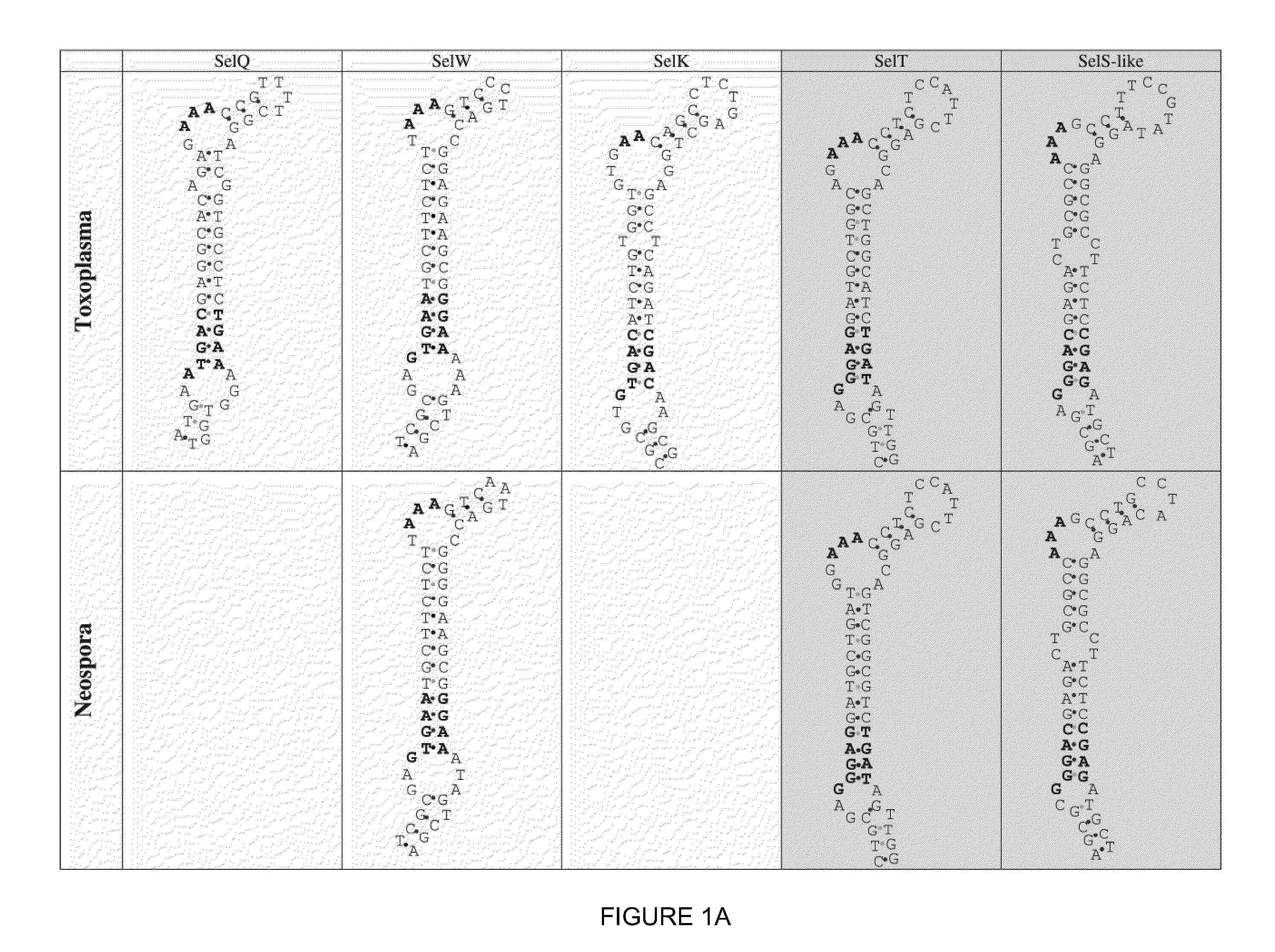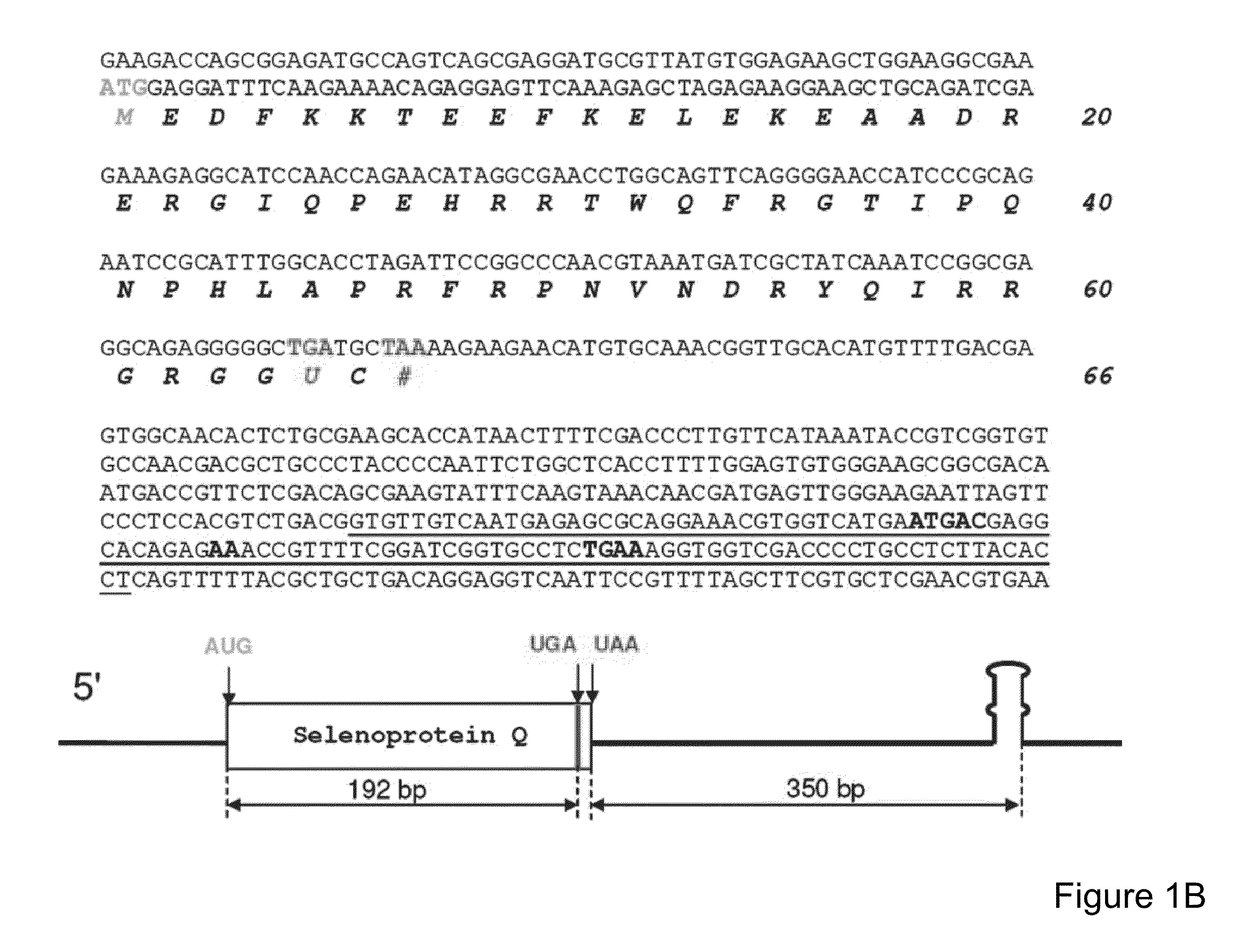Compositions and methods for the expression of selenoproteins in eukaryotic cells
a technology of selenoproteins and eukaryotic cells, applied in the field of selenoproteins in eukaryotes, can solve the problems of difficult recombinant expression targets of selenoproteins and the inability to express selenoproteins in eukaryotes
- Summary
- Abstract
- Description
- Claims
- Application Information
AI Technical Summary
Benefits of technology
Problems solved by technology
Method used
Image
Examples
example 1
Identification of a Noncanonical Form of Eukaryotic SECIS Element
[0190]A search for Toxoplasma selenoprotein genes was carried out by homology analyses involving all known selenoproteins as queries. This procedure identified homologs of four mammalian selenoproteins: Toxoplasma SelK (SEQ ID NO: 29), Toxoplasma SelW (SEQ ID NO: 41), Toxoplasma SelS-like (SEQ ID NO: 43), and Toxoplasma SelT (SEQ ID NO: 51) (FIGS. 6-9). Their genes had predicted Sec residues encoded by UGA codons. Analysis of the 3′-UTRs in these selenoprotein genes revealed the presence of canonical SECIS elements in Toxoplasma SelK and Toxoplasma SelW genes (FIG. 1A). However, no suitable structure was found in the SelT 3′-UTR. The use of relaxed settings and the loose pattern of SECISearch did not yield candidate SECIS structures in the Toxoplasma SelT gene.
[0191]The lack of a standard SECIS element in the Toxoplasma SelT gene suggested the presence of a non-canonical structure. Manual analysis of the Toxoplasma Sel...
example 2
The New 5′-GGAN-3′-Type of SECIS Element is Functional
[0192]Green fluorescent protein (GFP)-mouse SelH fusion proteins (SEQ ID NO: 62 nucleotide sequence and SEQ ID NO: 63 amino acid sequence) constructs were prepared in which the natural mouse SelH SECIS element (SEQ ID NO: 9) was replaced with a Toxoplasma SelT SECIS element (SEQ ID NO: 4) or SelS-like SECIS element (SEQ ID NO: 5) (FIG. 2A). Said constructs were used to express these proteins in mammalian HEK 293 (FIG. 2B) and NIH 3T3 (FIG. 2C) cells. Expression of the fusion protein was predicted to result in an 40 kDa product (FIG. 2A). Indeed, metabolic labeling of the transfected cells with 75Se revealed a 40 kDa band (lanes 1-8, upper panels in FIGS. 2B and 2C). This band was not present in cells transfected with the corresponding constructs lacking 3′UTRs (lanes 11, FIGS. 2B and 2C) or the constructs in which the Sec-encoding codons were mutated to cysteine codons (lanes 12, FIGS. 2B and 2C). It was also examined whether mam...
example 3
5′-AGAN-3′ to 5′-GGAN-3′ Xhimerics of Mammalian SECIS Elements are Functional
[0194]To further characterize the 5′-GGAN-3′ (preceded immediately at its 5′-terminus by a G residue) form of SECIS element, chimeric mammalian SECIS elements were tested to see if they were functional if they contain the novel, non-canonical quartet sequence. In this experiment, GFP-mouse SelS (SEQ ID NO: 64 nucleotide sequence and SEQ ID NO: 65 amino acid sequence) (Kryukovet al., 2003) and GFP-mouse SelM (SEQ ID NO: 66 nucleotide sequence and SEQ ID NO: 67 amino acid sequence) (Korotkov et al., 2002) constructs were used, in which the native 5′-UGAN-3′ (preceded immediately at the 5′-terminus by an A residue) 5′ proximal quartet sequences of the SECIS elements were changed to 5′-GGAN-3′ (preceded immediately at its 5′-terminus by a G residue) sequences (FIG. 3A) (chimeric mouse SelM SECIS element SEQ ID NO: 13 and chimeric mouse SelS SECIS element SEQ ID NO: 14 respectively). These constructs were transf...
PUM
| Property | Measurement | Unit |
|---|---|---|
| nucleic acid | aaaaa | aaaaa |
| reactivity | aaaaa | aaaaa |
| elongation factor | aaaaa | aaaaa |
Abstract
Description
Claims
Application Information
 Login to View More
Login to View More - R&D
- Intellectual Property
- Life Sciences
- Materials
- Tech Scout
- Unparalleled Data Quality
- Higher Quality Content
- 60% Fewer Hallucinations
Browse by: Latest US Patents, China's latest patents, Technical Efficacy Thesaurus, Application Domain, Technology Topic, Popular Technical Reports.
© 2025 PatSnap. All rights reserved.Legal|Privacy policy|Modern Slavery Act Transparency Statement|Sitemap|About US| Contact US: help@patsnap.com



